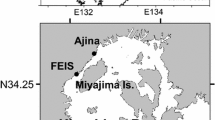Abstract
Ulva spp. are common in the intertidal zones of the Philippines, but, at certain times, could over-proliferate producing blooms or `green tide' in some protected bays. In Mactan Island (Cebu), central Philippines, at least two species constitute the Ulva population, either as free-living or attached form. The one referred to in the literature as `Ulva lactuca' mainly consists of free-living population while the species referred to as Ulva reticulata consists mainly of attached population. Based on morphological and physiological characteristics, `U. lactuca' differs much from the descriptions of the species from its type locality in Europe in having a crumpled texture of blade, presence of tooth-like protuberances at the margins, thinner thallus (40–50 μm) and more pyrenoids per cell (two to four). The species referred to as `U. lactuca' in the Philippines therefore is a different species. Two morphotypes consisted the `U. lactuca' population from Mactan – a thick thallus and a thin thallus type. However, both morphotypes cultured under the same condition in the laboratory could transform into the same thin-thallus type observed in the field. `Green tide' caused by `U. lactuca' occur almost regularly in Station 1 of Mactan Island, reaching an average biomass of up to 2.6 kg wet wt m−2 (or 0.5 kg dry wt m−2). Ulva reticulata, although was less abundant in the rocky tidal zone at most times, reaching an average biomass of only up to 0.15 kg wet wt m−2 (or 0.03 kg dry wt m−2) had caused green tide in Station 2 around February–March. Reproductive structures were not observed in both Ulva species during the survey period suggesting that vegetative fragmentation is the main mode of propagation. Vegetative tissues excised from the thallus can be induced to release biflagellated large and small zooids.
Similar content being viewed by others
References
Calumpong, H. & E. G. Meñez, 1997. Field Guide to the Common Mangroves, Seagrasses and Algae of the Philippines. Bookmark, Inc., Makati City, Philippines.
Cohen, T. & A. Neori, 1991. Ulva lactuca biofilters for marine fishpond effluents. Bot. mar. 34: 475–482.
DENR (Department of Environment and Natural Resources), 1993. Environmental Profile of Metro Cebu. A Technical Report of the DENR 7, Cebu City.
Dion, P., B. de Reviers & G. Coat, 1998. Ulva armoricana sp. nov. (Ulvales, Chlorophyta) from the coasts of Brittany (France). I. Morphological identification. Eur. J. Phycol. 33: 73–80.
Hiraoka, M. & S. Enomoto, 1998. The induction of reproductive cell formation of Ulva pertusa Kjellman (Ulvales, Ulvophyceae). Phycol. Res. 46: 199–203.
Jimenez del Rio, M., Z. Ramazanov & G. Garcia-Reina, 1996. Ulva rigida (Ulvales, Chlorophyta) tank culture as biofilters for dissolved inorganic nitrogen from fishpond effluents. Hydrobiologia 326/327: 61–66.
Morand, P., B. Carpenter, R. H. Charlier, J. Maze, M. Orlandini, B. A. Plunkett & J. de Waart, 1991. Bioconversion of seaweeds. In Guiry, M. D. & G. Blunden (eds), Seaweed Resources in Europe: Uses and Potential. John Wiley and Sons Ltd., Chichester: 95–148.
Neori, A., I. Cohen & H. Gordin, 1991. Ulva lactuca biofilters for marine fishpond effluents. II. Growth rate, yield and C:N ratio. Bot. mar. 34: 483–489.
Ohno, M., 1977. Effect of temperature on the growth rate of seaweeds in an aquatron culture system. Bull. Jpn. Soc. Phycol. 25 (Suppl): 257–263.
Ohno, M., D. B. Largo & T. Ikumoto, 1994. Growth rate, carrageenan yield and gel properties of cultured kappa-carrageenan producing red alga Kappaphycus alvarezii (Doty) Doty in the subtropical waters of Shikoku, Japan. J. appl. Phycol. 6: 1–5.
Trono, G. C. & E. T. Ganzon-Fortes, 1988. Philippine Seaweeds. Technology and Livelihood Resource Center. National Bookstore, Manila, Philippines.
Author information
Authors and Affiliations
Rights and permissions
About this article
Cite this article
Largo, D.B., Sembrano, J., Hiraoka, M. et al. Taxonomic and ecological profile of `green tide' species of Ulva (Ulvales, Chlorophyta) in central Philippines. Hydrobiologia 512, 247–253 (2004). https://doi.org/10.1023/B:HYDR.0000020333.33039.4b
Issue Date:
DOI: https://doi.org/10.1023/B:HYDR.0000020333.33039.4b




